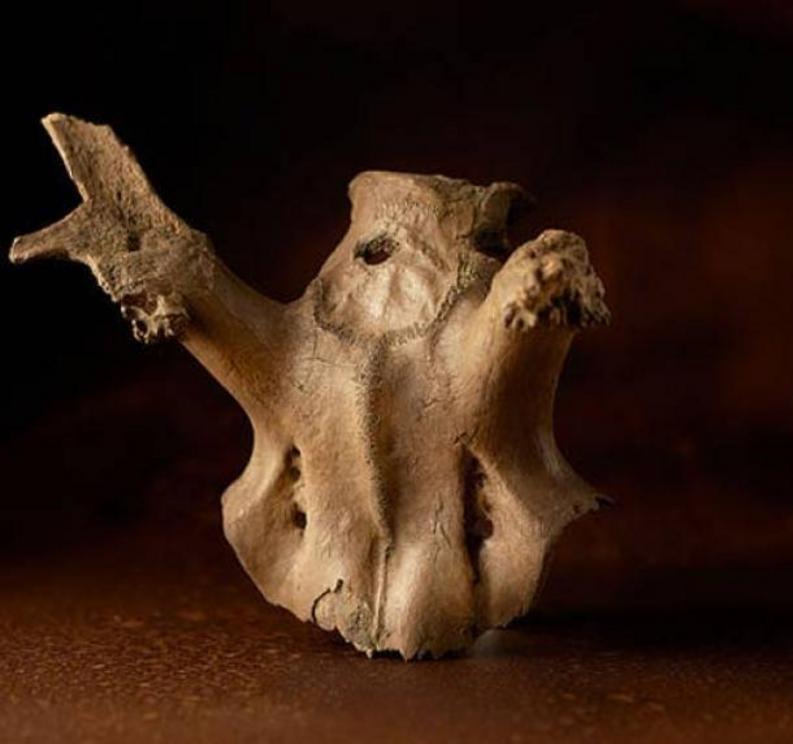11,000-year-old spiritualized deer masks whisper tales of a forgotten world
Deer skulls with carved eyeholes dating to 11,000 years ago have been discovered at Star Carr Mesolithic archaeological site about five miles (8.0 km) south of Scarborough in North Yorkshire, England.
Often referred to as the most important Mesolithic site in Great Britain, Star Carr was occupied during the early Mesolithic archaeological period and the site was preserved because Lake Flixton, where the skulls were discovered, was filled in with peat; which fortunately prevented the organic materials from oxidizing and rotting.
Three of the 33 deer skull head-pieces, as well as tools, weapons, and jewelry are currently on display in the Li Ka Shing Gallery at the Museum of Archaeology and Anthropology, Downing Street, Cambridge. The exhibition is called “ A Survival Story – Prehistoric Life at Star Carr ” and the exhibition curator Dr. Jody Joy told reporters at Haaretz, “This was a time before farming, before pottery, before metalworking – but the people who made their homes there returned to the same place for hundreds of years.”

One of the three Mesolithic deer skull headdresses from the new exhibition. (Museum of Archaeology and Anthropology )
11,000 years ago, ambient temperatures were rising, and the Ice Age retreated - causing ocean levels to rise. Archaeologists have unearthed profound amounts of hunting tools and weapons including “227 antler points used to hunt and fish” which is thought to be way in excess to what a small community would require. Further supporting the idea that Star Carr was not just a transit camp for nomadic hunter-gatherer-fishers, archaeologists involved in the Star Carr archaeology project found evidence of “Mesolithic-era wooden walkways and jetties into the lake” which are “the earliest-known examples of carpentry in Europe.”
Mesolithic Hunting Rituals
Archaeologists have a tendency to associate non-utile pre-agricultural artifacts to religion, but the Cambridge archaeologists involved at Star Carr raised the postulation that the deer headdresses “may have been items of camouflage worn while hunting.” While the visual of 30 plus hunters creeping through a woodland dressed as deer sets one’s imagination on fire, Dr Joy told reporters that “part of the antlers were removed… One suspects the deer wouldn’t have been fooled!”
To better understand why ancient people made such elaborate sacred objects, we must adopt a different world view and consider ‘animism.' Imagine for a moment a reality in which every material object and phenomena has an unseen life force; where material and spiritual realms are simply different parts of ‘one thing.’ In that world, free of pre-scientific reasoning, our forebears projected concepts of soul, spirit, and sentience onto fern and fauna, light and shadows, thunder, wind, rain and sunshine.

17th century drawing of a Tungus shaman wearing antlers. ( Public Domain )
To enhance hunting and fishing success, pre and post hunting rituals aimed at focusing and unifying the appropriate natural elements must have developed way back in pre-history, probably when we first developed superstitious thinking. Rituals are, after-all, the amplified and systemized big sisters of “touching wood” and “not walking under ladders!”
To gain insights into the original beliefs which led to the creation of spiritual tools like ancient masks, and to achieve a deeper understanding of ancient hunting rituals, archaeologists and anthropologists often study the rituals of modern-day hunter gatherers. According to a 2015 research paper published by NCBI, Mayan peasant-hunters across the Yucatan Peninsula in Mexico, particularly the X-Pichil community, still carry out a hunting ritual – Loojil Ts’oon, Loj Ts’oon or Carbine Ceremony.
These Mexican hunters believe they are “granted access to game by the gods and the Lords of the Animals” and they perceive that their rituals “renew the divine permission for hunting in order to continue deserving the gift of prey after a period of hunt.” According to Rufino Chuc , a hunter from X-Pichil, performing the Loojil Ts’oon ritual “legitimizes killing an animal" for a structure has been created for the “social, moral and emotional impact of the kill, ensuring the hunter is acting correctly before, during, and after the hunt.”

Ceremonial deposit, where most of the acts of the Loojil Ts’oon ritual occur. ( Dídac Santos-Fita; X-Pichil community, Quintana Roo, 2011 )
It can be concluded that hunting rituals are rooted in the profound belief that humans cannot live without making and ‘maintaining’ associations between the natural and supernatural elements of nature and our destiny. Today, all this is bagged up as a concept - “animism” - but this often shunned way of looking at the world was the natural software humans were born with, and it lasted hundreds of thousands of years before being crushed by the rise of organized religions.
This meteoric culture shift brought worshipping from the deepest recesses of caves to polished altars in holy buildings, and with every block of stone raised towards heaven, ancient indigenous peoples’ supernatural and spiritual perspectives were buried a little deeper.
All this considered, the deer masks discovered at Star Carr are not only rare and awe-inspiring artifacts from the Mesolithic, but they are priceless relics from a lost paradigm in human history, icons of a forgotten world view.

Deer antler headdress from the Scarborough Collections. ( Scarborough Museums Trust/ David Chalmers )

One of the three Mesolithic deer skull headdresses from the new Star Carr exhibition at the Museum of Archaeology and Anthropology. Source: Josh Murfitt / MAA
By Ashley Cowie
For the rest of this article please go to source link below.
For full references please use source link below.
